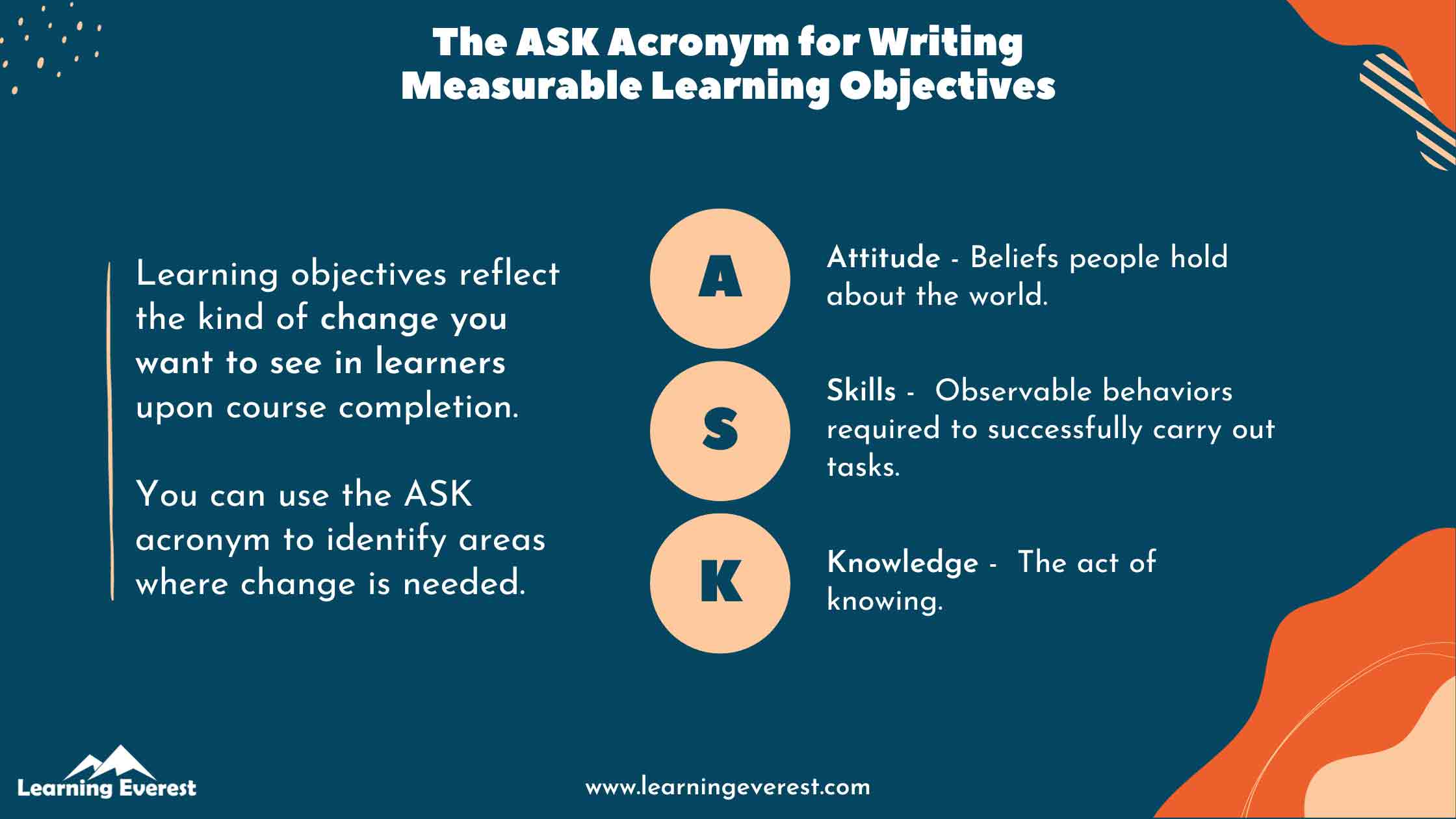Measurable learning objectives are the foundation of effective course design. Without them, instructional materials run the risk of lacking direction, purpose, and impact. Writing measurable learning objectives is an intricate task but it’s a skill set every L&D professional and educator needs to have. Often, having measurable or non-measurable learning objectives makes all the difference in the eventual learning outcomes of a course. This article will break down the concept of measurable learning objectives for you so you can take your course designs to the next level and highlight their importance in the learning process for learners.
Table of Contents
- Understanding Learning Objectives
- The Components of Well-Written, Measurable Learning Objectives
- The Importance of Measurable Learning Objectives
- Reason No. 1: Measurable Learning Objectives Guide Instructional Design
- Reason No. 2: Measurable Learning Objectives Enhance Learners’ Metacognition
- Reason No. 3: Measurable Learning Objectives Facilitate “Deliberate Practice”
- Reason No. 4: Measurable Learning Objectives Match the Learners’ Current Knowledge or Skill-Level
- Infographics
- Knowledge Check!
- Conclusion
Understanding Learning Objectives
First, let us define learning objectives. They refer to specific behaviors and knowledge areas learners are expected to demonstrate and develop after undertaking the learning activities in a course.
Learning objectives, thus, reflect the kind of change you want to see in learners upon course completion. This is one reason why there is such an emphasis on measurable learning objectives in L&D and education.
The areas where these changes occur can be represented using the acronym ASK.
- “A” stands for changes in attitudes. These are beliefs people hold about the world. Diversity training is an example of a change in attitudes.
- “S” refers to the development of skills. Skills are observable behaviors required to successfully carry out tasks. For example, operating machinery.
- “K” refers to gaining knowledge. Knowledge is the act of knowing. Product training is an example of learning aimed at increasing knowledge.

The ASK Acronym for Writing Measurable Learning Objectives
Not every course produces changes in all three areas, some might only develop skills and others might seek to change attitudes. Others may very well include learning objectives of all three types.
The Components of Well-Written, Measurable Learning Objectives
Now that you know the different kinds of outcomes learning objectives might delineate, let us look at the components of learning objectives. Writing measurable learning objectives is a formulaic task and alternative approaches fail to effectively communicate the end goal to learners.
The core components of a measurable learning objective are:
- A clear action that learners are expected to be able to perform by the end of the course. These actions are denoted by clear action verbs based on learning objective taxonomies such as Bloom’s taxonomy
- An observable behavioral manifestation of the action
- Optional quantified criteria to assess whether learners have successfully met the learning objective
For example, if we just take the first two components to write a learning objective for a soft-skills corporate training program on written business communication, it might sound something like this:
“By the end of the course, learners will be able to write emails for internal communication with team members, managers, and colleagues.”
- Here, the action is writing emails
- The observable behavioral outcome is internal communication with colleagues
Let us also look at an example that includes a quantifiable criterion to indicate successful learning:
“At the end of this module, the learner will be able to perform the first three steps of CPR on an adult training dummy.”
- Just like the previous learning objective, the action here is performing CPR
- The observable behaviors are the steps involved in CPR
- The quantified criteria are the first three steps of the CPR process
The purpose behind the third component in learning objectives is to guide assessment and clearly lay down the prerequisites for successful and unsuccessful learning. Objectives that contain all three components are, thus, highly measurable learning objectives.
However, in some training areas, it is not possible to define expected outcomes in quantifiable terms. In these cases, just a clear action verb and observable behavior sufficiently form a measurable learning objective.
The Importance of Measurable Learning Objectives
You can probably spot measurable and non-measurable learning objectives if you have made it this far. But why does it matter for learning objectives to be measurable?
Reason No. 1: Measurable Learning Objectives Guide Instructional Design
Effective instructional design rests on a dynamic foundation of measurable learning objectives, meaningful instructional activities, and well-built assessment criteria.
Instructional Designers and educators often start with writing learning objectives to clearly define what the outcomes of the course should look like. Learning objectives are tweaked and rephrased for enhanced clarity and alignment with the course’s desired learnings.
Only after learning objectives have been established do course designers move on to putting together the learning activities. In other words, learning objectives determine the instructional strategies used in a program. If the course has measurable learning objectives, the learning activities can be even more specific and relevant.
Additionally, learning objectives also help Instructional Designers develop assessments that test learners on relevant topics that enhance their learning. Oftentimes, learners feel course content and assessment are incongruent. This mainly happens due to a mismatch between learning objectives and assessment strategies. Thus, apart from guiding course content creation, measurable learning objectives also make assessments more relevant.
Reason No. 2: Measurable Learning Objectives Enhance Learners’ Metacognition
Metacognition is “thinking about thinking.” In learning, metacognition is a self-evaluating process through which learners try to gauge their own mastery or skill in a given knowledge area.
Since measurable learning objectives specify the action and behaviors learners are expected to perform at the end of a course, it gives them a framework for evaluating their own progress.
The objectives serve as a reference for them to compare their attitudes, skills, and knowledge against their actual levels. Through this process, learners consciously think of where they stand, which outcomes they demonstrate, and where they might need to improve. By doing so, learners end up self-directing their learning to some extent, making it more effective.
Reason No. 3: Measurable Learning Objectives Facilitate “Deliberate Practice”
Deliberate practice is practicing meeting a well-defined goal. Working towards a goal makes deliberate practice more effective than generic practice because learners get to monitor their proficiency with the subject matter. Since a measurable learning objective is a key indicator of what constitutes successful learning, deliberate practice in this direction ensures that learners get the most out of learning activities.
Reason No. 4: Measurable Learning Objectives Match the Learners’ Current Knowledge or Skill-Level
When writing learning objectives, Instructional Designers need to consider what their target learners already know. An effective course introduces new information using older information as reference points. Additionally, this new information primes learners for the next level of advancement if one exists.
Thus, by writing measurable learning objectives, the possibility of making courses that are too difficult or repetitive for learners decreases. At the same time, instructional activities leverage learners’ existing knowledge to make current learning relevant and impactful.
Infographics

4 Reasons Why You Need Measurable Learning Objectives – Infographics
Knowledge Check!
Conclusion
Learning objectives can influence a course or program’s entire trajectory by shaping learning activities, assessments, learner expectations, and learners’ interaction with the course. Measurable learning objectives lay down clear end goals that direct all these processes in the right direction, making it easier to gain the most out of the time and money invested in developing a training program.





